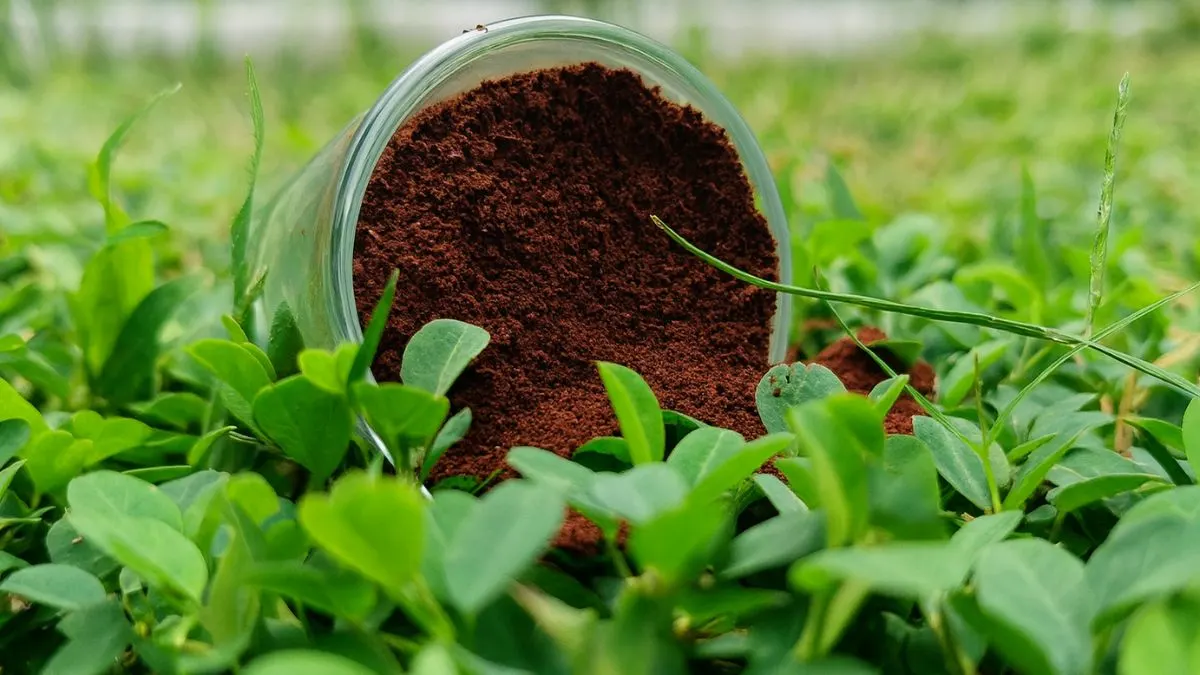Coffee is good for more than just helping you get a jump on the day — and gardeners across the United States, Canada, and elsewhere are discovering that coffee grounds are a fabulous way to use in their herb gardens or for edible flowers.
Some of the other known plants that benefit from coffee grounds are: roses, (most, not all) ferns, blueberries, and cranberries.
They are good for soil structure and deliver a feed of nitrogen when used correctly. But there are proper ways to use them — and incorrect ones. Let’s explore how to use coffee grounds to their best effect in your garden.
More About Using Coffee Grounds in the Garden

- Coffee grounds (and brewed coffee) are a source of nitrogen → encourages healthy green growth and strong stems.
- Also contain magnesium, potassium, and calcium → promote overall plant health.
- Improve soil aeration and water retention → stronger roots and resistance.
Used Coffee Grounds vs Fresh
- Golden Rule No.1: use used grounds rather than fresh.
- Fresh grounds = too acidic, may impact soil pH.
- Used grounds = slightly acidic, balance the soil, help plants flourish.
Personal Example: I once sprinkled fresh espresso powder on basil → leaves turned yellow. When I used grounds + compost → basil recovered.
Also Read: How Vermicomposting Cuts Waste and Supercharges Your Plants
Recycles for Used Coffee Grounds: In Your Garden
1. As a Soil Amendment
- Mix into topsoil.
- Loosen dense clay and enrich sandy soils.
2. Composting with Coffee Grounds
- Green ingredient = rich in nitrogen.
- Balance with brown materials like dry leaves, straw, cardboard.
3. As Liquid Fertilizer
- Mix 2 cups of grounds in a 5-gallon bucket of water.
- Let sit overnight, then pour around plants.
4. Mulching with Coffee Grounds
- Spread lightly around acid-loving plants like azaleas, blueberries, and hydrangeas.
- ⚠️ Don’t apply too thickly — may block airflow.
Which Plants Benefit the Most? 🌿
- Indoor Prayer Plant – thrives with coffee grounds + compost.
- Lupins – stronger seedlings when compost + grounds are used.
- Guduchi Plant – grows better with microbial activity boosted by coffee.
- Hawthorn Plants – benefit from richer soil when mixed with compost & coffee.
- Redbud Trees – use grounds for moisture retention and lush canopy.
- Celery – improved leaf development when added to compost.
- Amaranth – extra nitrogen boost makes it a nutrient powerhouse.
Also Read: What Is Peat Moss—and Should You Really Be Using It?
Advantages and Disadvantages of Coffee Grounds
Aspect |
Benefits |
Drawbacks |
Nutrition |
Provides nitrogen, magnesium, calcium, potassium |
Doesn’t provide all nutrients; need extras |
Soil Effect |
Improves structure, aeration, water retention |
Can compact if over-applied |
Compost |
Good green source for composting |
Needs browns to balance |
Cost & Access |
Cheap, often free from coffee shops |
Must dry properly to prevent mold |
Common Mistakes to Avoid
- Using fresh grounds → too acidic.
- Applying too much at once → can compact soil.
- Not balancing with compost/browns → nutrient imbalance.
- Using only coffee grounds → always mix with compost or manure.
Personal Experience with Coffee Grounds
I experimented with coffee grounds in tomato and spinach beds.
- Tomato with too many grounds → soil became crusty, plant stunted.
- Spinach with grounds + compost → lush, green, thriving.
Lesson: Balance is essential when using coffee grounds.
Also Read: Photoperiod Explained: The Hidden Key to Getting More Blooms
Conclusion
Coffee grounds are a cheap, eco-friendly way to enrich soil and boost plant growth.
✅ Rule of thumb: use used grounds, not fresh.
✅ Mix with compost or manure for balance.
✅ Apply moderately for best results.
From prayer plants to redbud trees, celery to amaranth — coffee grounds can feed gardens big and small around the world.






